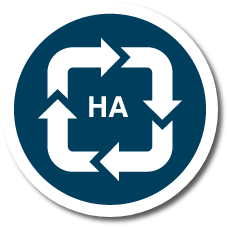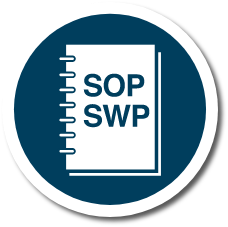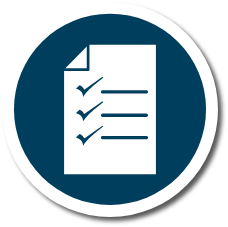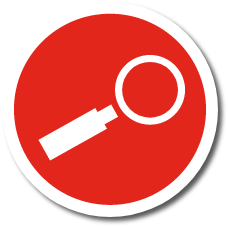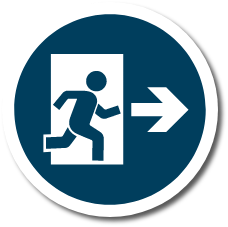
Investigations
An investigation is a systematic process to:
- uncover facts and factors involved in an incident
- determine the causes, including the root causes, of the incident
- identify corrective action to prevent reoccurrence
The root causes are the underlying problems that set the events in motion that led to the incident. Root causes explain why substandard acts and conditions were not corrected before an incident occurred.
Effective investigations turn a reactive situation into a proactive activity to improve workplace health and safety. By identifying and addressing the root causes, the workplace can prevent a similar reoccurrence of the incident. This, in turn, prevents injuries and illnesses, and the associated costs (both human and financial).
An employer should:
- Develop incident reporting processes
- Maintain defined investigation processes that assign responsibilities for conducting investigations. These processes, as a minimum, should meet legislative requirements
- Train employees for their incident response/investigation responsibilities
- As a minimum, conduct investigations to identify and address root causes as required by legislation, for incidents such as accidents that caused or may cause the death of a worker or required a worker to be admitted to a hospital as an in-patient for a period of 24 hours or more; dangerous occurrences; or work refusals
- Consider conducting investigations to identify and address root causes for:
- all incidents involving injury, whether or not a person saw a health care provider
- property/equipment damage incidents
- near-miss incidents
- environmental incidents
- Prioritize corrective actions to address root causes of incidents according to risk
- Implement corrective actions for root causes by the target dates
- Follow up on corrective actions to ensure implemented and effective
- Communicate investigation results to employees
- Ensure investigations are reviewed by management
- Develop and use a standard investigation form
The following legislation is not all inclusive. You are responsible for knowing and complying with all legislation applicable to your place of employment. Please refer to the original legislation to find out exactly what requirements apply to your business. WorkSafe Saskatchewan does not offer any advice as to your obligations under any applicable legislation, and assumes no responsibility or liability for your obligations under the applicable legislation.
You can download copies of legislation for free from http://www.publications.gov.sk.ca/legislation.cfm.
Saskatchewan Employment Act
Part III
Occupational Health and Safety
DIVISION 3
Duties
Duty to provide occupational health and safety programs
3‑20. (1) An employer at a prescribed place of employment shall establish and maintain an occupational health and safety program or a prescribed part of an occupational health and safety program in accordance with the regulations made pursuant to this Part.
(2) An occupational health and safety program at a prescribed place of employment must be established and designed in consultation with:
(a) the occupational health committee;
(b) the occupational health and safety representative; or
(c) the workers, if there is no occupational health committee and no occupational health and safety representative.
(3) An occupational health and safety program must include all prescribed documents, information and matters.
(4) An occupational health and safety program at a prescribed place of employment must be in writing and must be made available, on request, to the occupational health committee, the occupational health and safety representative, the workers or an occupational health officer.
(5) If the work at a place of employment is carried on pursuant to contracts between a contractor and two or more employers, the contractor shall coordinate the occupational health and safety programs of all employers at the place of employment.
(6) The director of occupational health and safety may order an employer to develop an occupational health and safety program for a place of employment if the director considers it to be in the interests of the health, safety and welfare of the employer’s workers based on the criteria set out in subsection (8).
(7) An order issued pursuant to subsection (6) must be in writing.
(8) In making an order pursuant to subsection (6), the director of occupational health and safety shall consider the following criteria:
(a) the frequency of occupationally related injuries and illnesses at the place of employment;
(b) the number and nature of the notices of contravention relating to the place of employment and the history of compliance with those orders and with compliance undertakings;
(c) any additional criteria that the director considers appropriate to protect the health, safety and welfare of workers.
Duty re policy statement on violence and prevention plan
3‑21. (1) An employer shall develop and implement a written policy statement and prevention plan to deal with potentially violent situations after consultation with:
(a) the occupational health committee;
(b) the occupational health and safety representative; or
(c) the workers, if there is no occupational health committee and no occupational health and safety representative.
(2) A policy statement and prevention plan required pursuant to subsection (1) must include any prescribed provisions.
(3) An employer shall ensure that an investigation is conducted into any incident of violence at the place of employment.
[S.S. 2023, c. 40, s. 7]
DIVISION 4
Occupational Health Committees and Occupational Health and Safety Representatives
Duties of committees
3‑27. (1) The duties of an occupational health committee are the following:
(a) to participate in the identification and control of health and safety hazards in or at the place of employment;
(b) to cooperate with the occupational health and safety service, if any, established for the place of employment;
(c) to establish, promote and recommend the means of delivery of occupational health and safety programs for the education and information of workers;
(d) to maintain records with respect to the duties of the committee pursuant to this section;
(e) to investigate any matter mentioned in section 3‑31;
(f) to receive, consider and resolve matters respecting the health and safety of workers;
(g) to carry out any other duties that are specified in this Part or the regulations made pursuant to this Part.
(2) An employer or contractor shall ensure that the duties of the occupational health committee imposed by this Part or the regulations made pursuant to this Part are not diminished by any other committee established within the place of employment by the employer or contractor.
DIVISION 4
Right to Refuse Dangerous Work; Discriminatory Action
Right to refuse dangerous work
3‑31. A worker may refuse to perform any particular act or series of acts at a place of employment if the worker has reasonable grounds to believe that the act or series of acts is unusually dangerous to the worker’s health or safety or the health or safety of any other person at the place of employment until:
(a) sufficient steps have been taken to satisfy the worker otherwise; or
(b) the occupational health committee has investigated the matter and advised the worker otherwise.
Occupational Health and Safety Regulations, 2020
PART 2
Notice Requirements
Accidents causing serious bodily injury
2‑2(1). An employer or contractor shall give notice to the ministry as soon as is reasonably possible of every accident at a place of employment that:
(a) causes or may cause the death of a worker; or
(b) will require a worker to be admitted to a hospital as an in‑patient for a period of 72 hours or more.
(2) The notice required by subsection (1) must include:
(a) the name of each injured or deceased worker;
(b) the name of the employer of each injured or deceased worker;
(c) the date, time and location of the accident;
(d) the circumstances related to the accident;
(e) the apparent injuries; and
(f) the name, telephone number and fax number of the employer or contractor or a person designated by the employer or contractor to be contacted for additional information.
(3) An employer or contractor shall provide each co‑chairperson or the representative with a copy of the notice required by subsection (1).
Dangerous occurrences
2‑3(1) In this section, "dangerous occurrence" means any occurrence that does not result in, but could have resulted in, a condition or circumstance set out in subsection 2‑2(1), and includes:
(a) the structural failure or collapse of:
(i) a structure, scaffold, temporary falsework or concrete formwork; or
(ii) all or any part of an excavated shaft, tunnel, caisson, coffer dam, trench or excavation;
(b) the failure of a crane or hoist or the overturning of a crane or unit of powered mobile equipment;
(c) an accidental contact with an energized electrical conductor;
(d) the bursting of a grinding wheel;
(e) an uncontrolled spill or escape of a toxic, corrosive or explosive substance;
(f) a premature detonation or accidental detonation of explosives;
(g) the failure of an elevated or suspended platform; and
(h) the failure of an atmosphere‑supplying respirator.
(2) An employer, contractor or owner shall give notice to the ministry as soon as is reasonably possible of any dangerous occurrence that takes place at a place of employment, whether or not a worker sustains injury.
(3) A notice required by subsection (2) must include:
(a) the name of each employer, contractor and owner at the place of employment;
(b) the date, time and location of the dangerous occurrence;
(c) the circumstances related to the dangerous occurrence; and
(d) the name, telephone number and fax number of the employer, contractor or owner or a person designated by the employer, contractor or owner to be contacted for additional information.
(4) An employer, contractor or owner shall provide each co‑chairperson or the representative with a copy of the notice required by subsection (2).
PART 3
General Duties
Occupational health and safety program
3‑11(1). Subject to subsection (2), an occupational health and safety program required by section 3‑20 of the Act must include:
(a) a statement of the employer’s policy with respect to the protection and maintenance of the health and safety of the workers;
(b) the identification of existing and potential risks to the health or safety of workers at the place of employment and the measures, including procedures to respond to an emergency, that will be taken to reduce, eliminate or control those risks;
(c) the identification of internal and external resources, including personnel and equipment, that may be required to respond to an emergency;
(d) a statement of the responsibilities of the employer, the supervisors and the workers;
(e) a schedule for the regular inspection of the place of employment and of work processes and procedures;
(f) a plan for the control of any biological or chemical substance handled, used, stored, produced or disposed of at the place of employment and, if appropriate, the monitoring of the work environment;
(g) a plan for training workers and supervisors in safe work practices and procedures, including any procedures, plans, policies or programs that the employer is required to develop pursuant to the Act or any regulations made pursuant to the Act that apply to the work of the workers and supervisors;
(h) a procedure for the investigation of accidents, dangerous occurrences and refusals to work pursuant to section 3‑31 of the Act at the place of employment;
(i) a strategy for worker participation in occupational health and safety activities, including audit inspections and investigations of accidents, dangerous occurrences and refusals to work pursuant to section 3‑31 of the Act; and
(j) a procedure to review and, if necessary, revise the occupational health and safety program at specified intervals that are not greater than 3 years and whenever there is a change of circumstances that may affect the health or safety of workers.
(2) The places of employment set out in Table 7 of the Appendix with 10 or more workers are prescribed for the purposes of section 3‑20 of the Act.
(3) An employer at a place of employment mentioned in subsection (2) shall establish an occupational health and safety program that meets the requirements set out in subsection (1).
Investigation of certain accidents
3‑18(1). Subject to section 3‑19, an employer shall ensure that every accident that causes or may cause the death of a worker or that requires a worker to be admitted to a hospital as an in‑patient for a period of 24 hours or more is investigated as soon as is reasonably possible by:
(a) the co‑chairpersons or their designates;
(b) the employer and the representative; or
(c) if there is no committee or representative, the employer.
(2) After the investigation of an accident, an employer, in consultation with the co‑chairpersons or the their designates, or with the representative, shall prepare a written report that includes:
(a) a description of the accident;
(b) any graphics, photographs or other evidence that may assist in determining the cause or causes of the accident;
(c) an explanation of the cause or causes of the accident;
(d) the immediate corrective action taken; and
(e) any long‑term action that will be taken to prevent the occurrence of a similar accident or the reasons for not taking action.
Prohibition re scene of accident
3‑19(1). Unless expressly authorized by statute or by subsection (2), no person shall, except for the purpose of saving life or relieving human suffering, interfere with, destroy, carry away or alter the position of any wreckage, article, document or thing at the scene of or connected with an accident causing a death until an officer has completed an investigation of the circumstances surrounding the accident.
(2) When an accident causing a death occurs and an officer is not able to complete an investigation of the circumstances surrounding the accident, an officer may, unless prohibited by statute, grant permission to move the wreckage, articles and things at the scene or connected with the accident to any extent that may be necessary to allow the work to proceed, only if:
(a) graphics, photographs or other evidence showing details at the scene of the accident are made before the officer grants permission; and
(b) the co‑chairpersons of a committee or the representative for the place of employment at which the accident occurred or their designates have inspected the site of the accident and agreed that the wreckage, article or thing may be moved.
Investigation of dangerous occurrences
3‑20(1). An employer, contractor or owner shall ensure that every dangerous occurrence as defined in subsection 2‑3(1) is investigated as soon as is reasonably possible by:
(a) the co‑chairpersons or their designates;
(b) the employer, contractor or owner and the representative; or
(c) if there is no committee or representative, the employer, contractor or owner.
(2) After the investigation of a dangerous occurrence, an employer, contractor or owner, in consultation with the co‑chairpersons or their designates or with the representative, shall prepare a written report that includes:
(a) a description of the dangerous occurrence;
(b) any graphics, photographs or other evidence that may assist in determining the cause or causes of the dangerous occurrence;
(c) an explanation of the cause or causes of the dangerous occurrence;
(d) the immediate corrective action taken; and
(e) any long‑term action that will be taken to prevent the occurrence of a similar dangerous occurrence or the reasons for not taking action.
Injuries requiring medical treatment
3‑21(1). An employer or contractor shall report to the co‑chairpersons, the representative or their designates any lost‑time injury at the place of employment that results in a worker receiving medical treatment.
(2) The employer or contractor shall allow the co‑chairpersons, the representative or their designates a reasonable opportunity to review the lost‑time injury mentioned in subsection (1) during normal working hours and without loss of pay or other benefits.
Harassment
3‑25(1). An employer, in consultation with the committee, shall develop a policy in writing to prevent harassment that includes:
(a) a definition of harassment that includes the definition in the Act;
(b) a statement that every worker is entitled to employment free of harassment;
(c) a commitment that the employer will make every reasonably practicable effort to ensure that no worker is subjected to harassment;
(d) a commitment that the employer will take corrective action respecting any person under the employer’s direction who subjects any worker to harassment;
(e) an explanation of how complaints of harassment may be brought to the attention of the employer;
(f) a statement that the employer will not disclose the name of a complainant or an alleged harasser or the circumstances related to the complaint to any person except if disclosure is:
(i) necessary for the purposes of investigating the complaint or taking corrective action with respect to the complaint; or
(ii) required by law;
(g) a reference to the provisions of the Act respecting harassment and the worker’s right to request the assistance of an occupational health officer to resolve a complaint of harassment;
(h) a reference to the provisions of The Saskatchewan Human Rights Code respecting discriminatory practices and the worker’s right to file a complaint with the Saskatchewan Human Rights Commission;
(i) a description of the procedure that the employer will follow to inform the complainant and the alleged harasser of the results of the investigation; and
(j) a statement that the employer’s harassment policy is not intended to discourage or prevent the complainant from exercising any other legal rights pursuant to any other law.
(2) An employer shall:
(a) implement the policy developed pursuant to subsection (1); and
(b) post a copy of the policy in a conspicuous place that is readily available for reference by workers.
Violence
3‑26(1). In this section, "violence" means the attempted, threatened or actual conduct of a person that causes or is likely to cause injury, and includes any threatening statement or behaviour that gives a worker reasonable cause to believe that the worker is at risk of injury.
(2) Places of employment that provide the following services or activities are prescribed for the purposes of subsection 3‑21(1) of the Act:
(a) services provided by health care facilities mentioned in clauses (a) to (e) and (l) of the definition of "health care facilities" in section 31‑1;
(b) pharmaceutical‑dispensing services;
(c) education services;
(d) police services;
(e) corrections services;
(f) other law enforcement services;
(g) security services;
(h) crisis counselling and intervention services;
(i) late night retail premises as defined in section 3‑27;
(j) financial services;
(k) the sale of alcoholic beverages or the provision of premises for the consumption of alcoholic beverages;
(l) taxi services;
(m) transit services.
(3) A policy statement and prevention plan required by subsection 3‑21(1) of the Act must be in writing and must include:
(a) the employer’s commitment to minimize or eliminate the risk;
(b) the identification of the worksites where violent situations have occurred or may reasonably be expected to occur;
(c) the identification of any staff positions at the place of employment that have been, or may reasonably be expected to be, exposed to violent situations;
(d) the procedure to be followed by the employer to inform workers of the nature and extent of risk from violence, including, except if the disclosure is prohibited by law, any information in the employer’s possession related to the risk of violence from persons who have a history of violent behaviour and whom workers are likely to encounter in the course of their work;
(e) the actions the employer will take to minimize or eliminate the risk, including the use of personal protective equipment, administrative arrangements and engineering controls;
(f) the procedure to be followed by a worker who has been exposed to a violent incident to report the incident to the employer;
(g) the procedure the employer will follow to document and investigate a violent incident reported pursuant to clause (f);
(h) a recommendation that any worker who has been exposed to a violent incident consult the worker’s physician for treatment or referral for post incident counselling; and
(i) the employer’s commitment to provide a training program for workers that includes:
(i) the means to recognize potentially violent situations;
(ii) procedures, work practices, administrative arrangements and engineering controls that have been developed to minimize or eliminate the risk to workers;
(iii) the appropriate responses of workers to incidents of violence, including how to obtain assistance; and
(iv) procedures for reporting violent incidents.
(4) If a worker receives treatment or counselling mentioned in clause (3) (h) or attends a training program mentioned in clause (3) (i), an employer shall credit the worker’s attendance as time at work and ensure that the worker loses no pay or other benefits.
(5) An employer shall make readily available for reference by workers a copy of the policy statement and prevention plan required by subsection 3‑21(1) of the Act.
(6) An employer shall ensure that the policy statement and prevention plan required by subsection 3‑21(1) of the Act is reviewed and, if necessary, revised every 3 years and whenever there is a change of circumstances that may affect the health or safety of workers.
PART 4
Committees and Representatives
Special meetings
4‑7. Either co‑chairperson mentioned in section 4‑6 may call a special meeting of a committee to deal with urgent concerns, imminent dangers to health or safety, investigations of accidents or dangerous occurrences or refusals to work pursuant to section 3‑31 of the Act.
Meetings of employers and representatives
4‑10(1). At a place of employment where a representative is designated, an employer shall meet with the representative regularly to discuss health and safety matters.
(2) A representative may call a special meeting with an employer to deal with urgent concerns, imminent dangers to health or safety or investigations of accidents or dangerous occurrences.
Opportunity for necessary activities
4‑11(1). An employer or contractor shall ensure that:
(a) the members of a committee or a representative are allowed to examine any log book, inspection report or other record that the employer or contractor is required to keep at the place of employment pursuant to the Act or any regulations made pursuant to the Act;
(b) members of a committee or a representative have reasonable opportunity, during normal working hours and without loss of pay or other benefits, to receive and investigate concerns, to inform workers of the provisions of the Act or any regulations made pursuant to the Act or to conduct other business proper to the functioning of the committee or the representative;
(c) members of a committee have reasonable opportunity to hold a special meeting pursuant to section 4‑7 at any time; and
(d) a representative has reasonable opportunity to hold a special meeting pursuant to subsection 4‑10(2) at any time.
(2) An employer or contractor shall ensure that no member of a committee or representative who participates in a regular meeting held pursuant to section 4‑4 or subsection 4‑10(1) or in a special meeting held pursuant to section 4‑7 or 4‑12 or subsection 4‑10(2) loses any pay or other benefits as a result of that participation.
PART 6
General Health Requirements
Musculoskeletal injuries
6‑18(1). In this section, "musculoskeletal injury" means an injury or disorder of the muscles, tendons, ligaments, nerves, joints, bones or supporting vasculature that may be caused or aggravated by any of the following:
(a) repetitive motions;
(b) forceful exertions;
(c) vibration;
(d) mechanical compression;
(e) sustained or awkward postures;
(f) limitations on motion or action;
(g) other ergonomic stressors.
(2) An employer or contractor, in consultation with the committee, shall regularly review the activities at the place of employment that may cause or aggravate musculoskeletal injuries.
(3) If a risk of musculoskeletal injury is identified, an employer or contractor shall:
(a) inform each worker who may be at risk of developing musculoskeletal injury of that risk and of the signs and common symptoms of any musculoskeletal injury associated with that worker’s work; and
(b) provide effective protection for each worker who may be at risk, which may include any of the following:
(i) providing equipment that is designed, constructed, positioned and maintained to reduce the harmful effects of an activity;
(ii) implementing appropriate work practices and procedures to reduce the harmful effects of an activity;
(iii) implementing work schedules that incorporate rest and recovery periods, changes in workload or other arrangements for alternating work to reduce the harmful effects of an activity.
(4) An employer or contractor shall ensure that workers who may be at risk of developing musculoskeletal injury are instructed in the safe performance of the worker’s work, including the use of appropriate work practices and procedures, equipment and personal protective equipment.
(5) If a worker has symptoms of musculoskeletal injury, an employer or contractor shall:
(a) advise the worker to consult a physician or a health care professional who is registered or licensed pursuant to an Act to practise any of the healing arts; and
(b) promptly review the activities of that worker and of other workers doing similar tasks to identify any cause of the symptoms and to take corrective measures to avoid further injuries.
Exposure control plan
6‑22(1). In this section:
"engineering controls" means physical controls or barriers that isolate or remove an infectious disease hazard and includes:
(a) medical devices approved by Health Canada that have engineered sharps injury protections;
(b) sharps disposal containers;
(c) needleless systems and needles with engineered sharps injury protections as defined in section 31‑9; and
(d) other devices that isolate or remove sharps hazards;
"expose" means harmful contact with an infectious material or organism from inhalation, ingestion, skin or mucous membrane contact or percutaneous injury;
"exposure control plan" means an exposure control plan required pursuant to subsection (2);
"infectious material or organism" means an infectious material or organism that has been identified in an approved manner as an infectious disease hazard that poses a significantly increased exposure risk to a worker or self‑employed person.
(2) If workers are required to handle, use or produce an infectious material or organism or are likely to be exposed at a place of employment, an employer, in consultation with the committee, shall develop and implement an exposure control plan to eliminate or minimize worker exposure.
(3) An exposure control plan must:
(a) be in writing;
(b) identify any workers at the place of employment who may be exposed;
(c) identify categories of tasks and procedures that may put workers at risk of exposure;
(d) describe the ways in which an infectious material or organism can enter the body of a worker and the risks associated with that entry;
(e) describe the signs and symptoms of any disease that may arise for a worker exposed at the place of employment;
(f) describe infection control measures to be used, such as the following:
(i) vaccination;
(ii) engineering controls;
(iii) personal protective equipment;
(iv) safe work practices and procedures; and
(v) standard practices that incorporate universal precautions;
(g) identify the limitations of the infection control measures described pursuant to clause (f);
(h) set out procedures to be followed in each of the following circumstances:
(i) if there has been a spill or leak of an infectious material or organism;
(ii) if a worker has been exposed;
(iii) if a worker believes that the worker has been exposed;
(i) set out the methods of cleaning, disinfecting or disposing of clothing, personal protective equipment or other equipment contaminated with an infectious material or organism that must be followed and indicate who is responsible for carrying out those activities;
(j) describe the training to be provided to workers who may be exposed and the means by which this training will be provided;
(k) require the investigation and documentation, in a manner that protects the confidentiality of the exposed worker, of any work‑related exposure incident, including the route of exposure and the circumstances in which the exposure occurred; and
(l) require the investigation of any occurrence of an occupationally transmitted infection or infectious disease to identify the route of exposure and implement measures to prevent further infection.
(4) If subsection (2) applies to an employer, that employer must describe in the employer’s exposure control plan the steps that will be taken to ensure compliance with this section and, if applicable, subsection 31‑9(3).
(5) No employer shall allow a worker to undertake any tasks or procedures mentioned in clause (3) (c) unless the worker has been trained with respect to the exposure control plan and the use of control measures appropriate for the task or procedure undertaken.
(6) An employer, in consultation with the committee, shall review the adequacy of the exposure control plan, and amend the plan if necessary, at least every 2 years or as necessary to reflect advances in infection control measures, including engineering controls.
(7) An employer shall make a copy of the exposure control plan and any amendments to that plan readily available to every worker who may be exposed.
(8) An employer shall:
(a) inform workers who are required to handle, use or produce an infectious material or organism or who may be exposed at a place of employment of the following:
(i) any vaccine recommended for workers with respect to that risk in the Canadian Immunization Guide, published by the Public Health Agency of Canada , and recommended by:
(A) a medical health officer appointed pursuant to The Public Health Act or a designated public health officer within the meaning of The Public Health Act, 1994whose powers and responsibilities include those set out in Part IV of The Public Health Act, 1994; or
(B) a physician with expertise in immunization or the control of communicable diseases;
(ii) the risks associated with taking a vaccine mentioned in subclause (i);
(b) with the worker’s consent, arrange for the worker to receive any vaccination recommended pursuant to subclause (a) (i) during the worker’s normal working hours and reimburse the worker for any costs associated with receiving the vaccination; and
(c) if a worker cannot receive a vaccination mentioned in subclause (a) (i) during the worker’s normal working hours, credit the worker’s attendance for the vaccination as time at work and ensure that the worker does not lose any pay or other benefits.
(9) If a worker has been exposed to blood or potentially infectious bodily fluids at a place of employment, an employer shall, with the consent of the worker, during the worker’s normal working hours, arrange for immediate medical evaluation and intervention by a qualified person in an approved manner and for confidential post‑exposure counselling.
(10) If a worker cannot receive medical evaluation, medical intervention or post‑exposure counselling during the worker’s normal working hours, an employer shall credit the worker’s attendance for evaluation, intervention or counselling as time at work and shall ensure that the worker does not lose any pay or other benefits.
(11) Nothing in these regulations prohibits an employer or contractor from purchasing supplies in bulk together with another employer or contractor but each employer or contractor is responsible for ensuring the employer or contractor’s compliance with these regulations.
PART 21
Chemical and Biological Substances
Report of worker's exposure
21‑10(1). If an accumulation, spill or leak of a chemical substance or biological substance listed in Table 16 or 17 of the Appendix occurs and results in the exposure of a worker to the chemical substance or biological substance to an extent that may affect the health or safety of the worker, an employer, in consultation with the committee, shall investigate the incident as soon as is reasonably possible and prepare a written report that includes:
(a) a description of the incident, including the date and all affected worksites;
(b) the names of the substances released and the characteristics of the substances;
(c) for each substance released, the estimated duration and the extent of each worker’s exposure;
(d) the name of each worker exposed and the manner in which the substance entered the worker’s body;
(e) the causes of the incident; and
(f) any corrective actions taken to prevent occurrence of a similar incident.
(2) An employer shall provide a copy of a report prepared pursuant to subsection (1) to any worker who was exposed to the chemical substance or biological substance that was released.
PART 23
Asbestos
Medical examinations
23‑16(1). In this section, "worker" means a worker who is regularly employed in an asbestos process.
(2) Not less than once every 2 years and with consent of the worker, the employer shall:
(a) offer to arrange for a medical examination of the worker during the worker’s normal working hours; and
(b) reimburse the worker for any part of the cost of the medical examination that the worker cannot recover.
(3) If a worker cannot attend a medical examination mentioned in subsection (2) during the worker’s normal working hours, an employer shall credit the worker’s attendance at the examination as time at work and ensure that the worker does not lose any pay or other benefits.
(4) A medical examination arranged pursuant to subsection (2) must include:
(a) a comprehensive medical history and physical examination with special attention to the respiratory system;
(b) lung‑function tests, including forced vital capacity and forced expiratory volume at 1 second; and
(c) any further medical investigations that are necessary for the diagnosis of an asbestos‑related disease.
PART 31
Additional Protection for Health Care Workers
Patient moving and handling
31‑4(1). If workers are required or permitted to mobilize, lift, hold, turn, position or transfer patients, residents or clients, an employer:
(a) in consultation with the committee, shall develop a written program specifying:
(i) the procedures to be used by a competent person to assess whether a patient, resident or client requires assistance to move; and
(ii) subject to subsection (2), the procedures and techniques that workers must use when mobilizing, lifting, holding, turning, positioning or transferring a patient, resident or client under all reasonably foreseeable circumstances;
(b) shall implement the program developed pursuant to clause (a);
(c) shall make readily available for reference by workers a copy of the program developed pursuant to clause (a);
(d) if the program developed pursuant to clause (a) and implemented pursuant to clause (b) requires the use of equipment, shall provide equipment, sufficient in quantity, capacity and quality to protect the health and safety of workers, to assist with mobilizing, lifting, holding, turning, positioning or transferring patients, residents or clients;
(e) in consultation with the committee, shall develop a written plan respecting the ongoing evaluation and selection of the equipment mentioned in clause (d);
(f) shall consult with workers who use the equipment mentioned in clause (d) on the ongoing evaluation and selection of that equipment;
(g) shall ensure that workers use, and that competent persons maintain, the equipment mentioned in clause (d) according to the manufacturer’s recommendations;
(h) shall ensure that a preventative maintenance program for the equipment mentioned in clause (d) is implemented that meets the manufacturer’s recommendations; and
(i) shall ensure that workers:
(i) are instructed in the causes of injuries resulting from mobilizing, lifting, holding, turning, positioning or transferring patients, residents or clients and the means to prevent those injuries;
(ii) subject to subsection (2) and in addition to the requirements of section 3‑8, are trained in, and use, the procedures and techniques of mobilizing, lifting, holding, turning, positioning and transferring patients, residents or clients as described in subclause (a)
(ii); and (iii) are trained in the use of the equipment mentioned in clause (d) that the workers will be expected to use at the worksite.
(2) The procedures and techniques mentioned in subclauses (1) (a) (ii) and (i) (ii) must be consistent with the requirements set out in section 6‑18.
(3) If a patient, resident or client has been assessed as requiring assistance to move, an employer shall:
(a) ensure that the status of the patient, resident or client and the appropriate techniques to mobilize, lift, hold, turn, position or transfer the patient, resident or client are clearly identified in writing or by other visual means at or near the location of the patient, resident or client; and
(b) if the technique specified in clause (a) requires more than 1 worker or the use of equipment, ensure that the number of workers needed and the equipment to be used are also clearly specified in writing or by other visual means at or near the location of the patient, resident or client.
(4) An employer, in consultation with the committee, shall review all injuries resulting from mobilizing, lifting, holding, turning, positioning or transferring patients, residents or clients to determine the causes of the injuries. (
5) An employer shall take appropriate action to prevent the occurrence of injuries similar to an injury reviewed pursuant to subsection (4).
(6) If a program developed pursuant to clause (1) (a) and implemented pursuant to clause (1) (b), or a technique identified in subsection (3), specifies the use of equipment or the assistance of another worker, no employer shall require or permit a worker to mobilize, lift, hold, turn, position or transfer a patient, resident or client without the use of the device or the assistance of the other worker.
(7) Except in a life‑threatening emergency, the employer shall not require or permit a worker to mobilize, lift, hold, turn, position or transfer a patient, resident or client until the patient, resident or client has been assessed pursuant to the progra
Instructor-Led
Self-Directed
Instructor-Led
- Energy Safety Canada - Incident and Accident Investigation
- Safety Association of Saskatchewan Manufacturers - Investigations
- Safety Association of Saskatchewan Manufacturers - OH&S Committee Level 1 & 2
- Saskatchewan Association for Safe Workplaces in Health - Incident Reporting and Investigation
- Service Hospitality – Incident Reporting & Investigation
Self-Directed
These forms do not replace the legislation. Please carefully review the Disclaimer on each form that you choose to use, and refer to the relevant legislation to find out exactly what requirements apply to your business. WorkSafe Saskatchewan assumes no responsibility or liability for the use of these forms, nor does WorkSafe Saskatchewan offer any advice as to your obligations under any applicable legislation.
CCOHS
Safety Associations
- Energy Safety Canada, Petroleum Industry Safety Association
- Motor Safety Association
- Saskatchewan Construction Safety Association
- Service Hospitality



